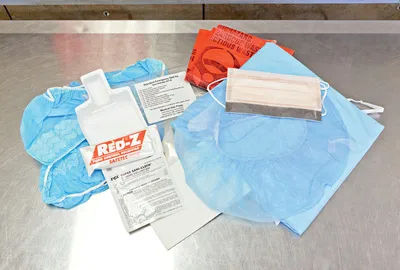
Laboratory Procedures for Veterinary Technicians E-Book
Laboratory Procedures for Veterinary Technicians E-Book
- 433 pages
- English
- ePUB (mobile friendly)
- Available on iOS & Android
Laboratory Procedures for Veterinary Technicians E-Book
Laboratory Procedures for Veterinary Technicians E-Book
About this book
**Selected for Doody's Core Titles® 2024 with "Essential Purchase" designation in Veterinary Nursing & Technology** Ensure you're at your clinical best! Laboratory Procedures for Veterinary Technicians, 7th Edition covers the broad spectrum of laboratory procedures that veterinary technicians need to perform effectively in the practice setting. Comprehensive content presents the fundamentals of microbiology, hematology, urinalysis, immunology, and cytology, along with the laboratory procedures used to perform the most widely used tests such as complete blood count, urinalysis, and immunologic assays. This thoroughly updated edition includes an expanded Quality Control and Record Keeping chapter along with the latest advances in veterinary clinical procedures to prepare you for real-life laboratory work.- Comprehensive coverage gives you a solid foundation in the fundamentals of microbiology, hematology, urinalysis, immunology, and cytology, along with the laboratory procedures used to perform related tests.- Provides the latest information needed to successfully perform a broad spectrum of laboratory tests, including complete blood count, urinalysis, and immunologic assays.- Step-by-step procedure boxes offer quick access to the skills you must perform during your educational program, as well as procedures that are commonly performed by vet techs in private practice.- A comprehensive glossary of terms at the end of the text offers accurate, concise definitions.- Vet Tech Threads provide you with introductions, suggested readings, boxed technician notes, learning objectives, chapter outlines, key terms, and a glossary for easy navigation through chapters and more focused learning.- NEW! Completely updated content throughout reflects the latest advances in veterinary clinical laboratory procedures for improved patient service and higher practice revenue.- NEW! Thoroughly updated and expanded Quality Control and Record Keeping chapter ensures you have the most current information in this vital area.- UPDATED! Immunology section includes the latest information in this fast-growing veterinary technology area.
Frequently asked questions
- Essential is ideal for learners and professionals who enjoy exploring a wide range of subjects. Access the Essential Library with 800,000+ trusted titles and best-sellers across business, personal growth, and the humanities. Includes unlimited reading time and Standard Read Aloud voice.
- Complete: Perfect for advanced learners and researchers needing full, unrestricted access. Unlock 1.4M+ books across hundreds of subjects, including academic and specialized titles. The Complete Plan also includes advanced features like Premium Read Aloud and Research Assistant.
Please note we cannot support devices running on iOS 13 and Android 7 or earlier. Learn more about using the app.
Information
Introduction
- Unit Outline
- Chapter 1: Safety Concerns and OSHA Standards, 2
- Chapter 2: General Laboratory Equipment, 10
- Chapter 3: The Microscope, 16
- Chapter 4: The Metric System and Lab Calculations, 23
- Chapter 5: Quality Control and Record Keeping, 27
- Unit Objectives
- Describe the role of the veterinary technician in the clinical laboratory.
- List and describe the regulations related to safety concerns in the veterinary practice laboratory.
- Describe the components of a quality control program for the veterinary practice laboratory.
- Identify, use, and maintain common laboratory equipment.
- Use the metric system to perform calculations and measurements.
Safety Concerns and OSHA Standards
- • Discuss the requirements of a chemical hygiene plan.
- • Identify mechanisms for minimizing exposure to hazards in the veterinary practice laboratory.
- • Describe general concerns related to laboratory design.
- • Identify, use, and care for personal protective equipment.
- • Discuss criteria for evaluating Internet resources.




- • Comply with all relevant OSHA standards.
- • Correct any safety and health hazards in the workplace.
- • Educate employees about any potential w...
Table of contents
- Cover image
- Title Page
- Table of Contents
- IFC
- Copyright Page
- Dedication
- Contributors
- Preface
- Acknowledgments
- Unit 1 The Veterinary Practice Laboratory
- Unit 2 Hematology
- Unit 3 Hemostasis
- Unit 4 Immunology
- Unit 5 Urinalysis
- Unit 6 Clinical Chemistry
- Unit 7 Microbiology
- Unit 8 Parasitology
- Unit 9 Cytology
- Appendix A Review Questions
- Appendix B Reference Ranges
- Appendix C Bacterial Pathogens of Veterinary Importance
- Appendix D Professional Associations Related to Veterinary Clinical Laboratory Diagnostics
- Appendix E Common Parasites of Some Exotic Animal Species
- Appendix F Example of a Standard Protocol for Reporting Results of a Urinalysis Laboratory Report
- Appendix G Taxonomic Classification of Parasites
- Appendix H Zoonotic Internal Parasites
- Glossary
- Resources
- Index